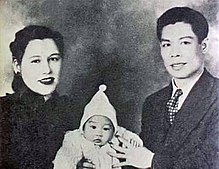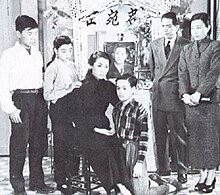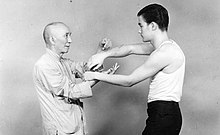Bruce Lee.
This is a Chinese name: the family name is Lee.
| Bruce Lee | |
|---|---|

Lee in 1971
| |
| Background information | |
| Chinese name | 李小龍 (traditional) |
| Chinese name | 李小龙 (simplified) |
| Pinyin | Lǐ Xiǎolóng (Mandarin) |
| Born | November 27, 1940 Chinatown, San Francisco, U.S. |
| Died | July 20, 1973 (aged 32) Kowloon Tong, British Hong Kong |
| Resting place | Lake View Cemetery, Seattle |
| Origin | Kowloon, Hong Kong |
| Alma mater | University of Washington |
| Occupation |
|
| Years active | 1950–1973 |
| Nationality | Hong Kong United States |
| Spouse(s) | Linda Emery (m. 1964) |
| Children | Brandon Lee (1965–1993) Shannon Lee (born 1969) |
| Parents | Lee Hoi-chuen (1901–1965) Grace Ho (1907–1996) |
| Siblings | Robert Lee (born 1948) |
| Ancestry | Shunde, Guangdong, China |
November 27, 1940 – July 20, 1973), known professionally as Bruce Lee (Chinese: 李小龍), was a Hong Kong and American actor, film director, martial artist, martial arts instructor, philosopher and founder of the martial art Jeet Kune Do, one of the wushu or kungfu styles. Lee was the son of Cantonese opera star Lee Hoi-chuen.
He is widely considered by commentators, critics, media, and other martial artists to be one of the most influential martial artists of all time, and a pop culture icon of the 20th century.He is often credited with helping to change the way Asians were presented in American films.
Lee was born in Chinatown, San Francisco, on November 27, 1940, to parents from Hong Kong and was raised in Kowloon, Hong Kong, with his family until his late teens. He was introduced to the film industry by his father and appeared in several films as a child actor. Lee moved to the United States at the age of 18 to receive his higher education, at the University of Washington, at Seattle and it was during this time that he began teaching martial arts. His Hong Kong and Hollywood-produced films elevated the traditional Hong Kong martial arts film to a new level of popularity and acclaim, sparking a surge of interest in Chinese martial artis the West in the 1970s. The direction and tone of his films changed and influenced martial arts and martial arts films in the US, Hong Kong, and the rest of the world.
He is noted for his roles in five feature-length films: Lo Wei's The Big Boss(1971) and Fist of Fury (1972); Golden Harvest's Way of the Dragon(1972), directed and written by Lee; Golden Harvests and Warner Brothers' Enter the Dragon (1973) and The Game of Death (1978), both directed by Robert Clous Lee became an iconic figure known throughout the world, particularly among the Chinese, as he portrayed Chinese nationalism in his films.He trained in the art of Wing Chun and later combined his other influences from various sources, in the spirit of his personal martial arts philosophy, which he dubbed Jeet Kune Do (The Way of the Intercepting Fist). Lee held dual nationality in Hong Kong and the US.He died in Kowloon Tong on July 20, 1973, at the age of 32.
Early life
Bruce Lee was born on November 27, 1940, at the Chinese Hospital, in San Francisco's Chinatown.
According to the Chinese zodiac, Lee was born in both the hour and the year of the Dragon, which according to tradition is a strong and fortuitous omen.
Lee and his parents returned to Hong Kong when he was three months old.
Bruce's father, Lee Hoi-chuen, (李海泉) was Han Chinese, and his mother, Grace Ho (何愛瑜), was of Eurasian ancestry.
Grace Ho was the adopted daughter of Ho Kom-tong (Ho Gumtong, 何甘棠) and the half-niece of Sir Robert Ho-tung, both notable Hong Kong businessmen and philanthropists.Bruce was the fourth child of five children: Phoebe Lee (李秋源), Agnes Lee (李秋鳳), Peter Lee (李忠琛), and Robert Lee (李振輝).
Grace's parentage remains unclear. Linda Lee in her 1989 biography The Bruce Lee Story suggests that Grace had a German father and was a Catholic. Bruce Thomas in his influential 1994 biography Bruce Lee: Fighting Spiritsuggests that Grace had a Chinese mother and a German father. Lee's relative Eric Peter Ho in his 2010 book Tracing My Children’s Lineage suggests that Grace was born in Shanghai to a Eurasian woman named Cheung King-sin.
Names
Lee's Cantonese birth name was Lee Jun-fan (李振藩). The name homophonically means "return again", and was given to Lee by his mother, who felt he would return to the United States once he came of age.
Because of his mother's superstitious nature, she had originally named him Sai-fon (細鳳), which is a feminine name meaning "small phoenix".
The English name "Bruce" is thought to have been given by the hospital attending physician, Dr. Mary Glover.
Lee had three other Chinese names: Lee Yuen-cham (李源鑫), a family/clan name; Lee Yuen-kam (李元鑒), which he used as a student name while he was attending La Salle College, and his Chinese screen name Lee Siu-lung (李小龍; Siu-lung means "little dragon"). Lee's given name Jun-fan was originally written in Chinese as 震藩, however, the Jun (震) Chinese character was identical to part of his grandfather's name, Lee Jun-biu (李震彪). Hence, the Chinese character for Jun in Lee's name was changed to the homonym 振 instead, to avoid naming taboo in Chinese tradition.
Family
Lee's father, Lee Hoi-chuen, was one of the leading Cantonese opera and film actors at the time, and was embarking on a year-long opera tour with his family on the eve of the Japanese invasion of Hong Kong. Lee Hoi-chuen had been touring the United States for many years and performing at numerous Chinese communities there.
Although many of his peers decided to stay in the US, Lee Hoi-chuen returned to Hong Kong after Bruce's birth. Within months, Hong Kong was invaded and the Lees lived for three years and eight months under Japanese occupation. After the war ended, Lee Hoi-chuen resumed his acting career and became a more popular actor during Hong Kong's rebuilding years.
Lee's mother, Grace Ho, was from one of the wealthiest and most powerful clans in Hong Kong, the Ho-tungs. She was the half-niece of Sir Robert Ho-tung, the Eurasian patriarch of the clan. As such, the young Bruce Lee grew up in an affluent and privileged environment. Despite the advantage of his family's status, the neighborhood in which Lee grew up became overcrowded, dangerous, and full of gang rivalries due to an influx of refugees fleeing communist China for Hong Kong, at that time a British Crown colony.
After Lee was involved in several street fights, his parents decided that he needed to be trained in the martial arts. Lee's first introduction to martial arts was through his father, from whom he learned the fundamentals of Wu-style t'ai chi ch'uan.
Wing Chun
The largest influence on Lee's martial arts development was his study of Wing Chun. Lee began training in Wing Chun when he was 16 years old under the Wing Chun teacher Yip Man in 1957, after losing several fights with rival gang members. Yip's regular classes generally consisted of the forms practice, chi sao (sticking hands) drills, wooden dummy techniques, and free-sparring.
There was no set pattern to the classes.
Yip tried to keep his students from fighting in the street gangs of Hong Kong by encouraging them to fight in organized competitions.
After a year into his Wing Chun training, most of Yip Man's other students refused to train with Lee after they learned of his mixed ancestry, as the Chinese were generally against teaching their martial arts techniques to non-Asians. Lee's sparring partner, Hawkins Cheung states, "Probably fewer than six people in the whole Wing Chun clan were personally taught, or even partly taught, by Yip Man".
However, Lee showed a keen interest in Wing Chun, and continued to train privately with Yip Man and Wong Shun Leung in 1955. Wan Kam Leung, a student of Wong's, witnessed a sparring bout between Wong and Lee, and noted the speed and precision with which Lee was able to deliver his kicks. Lee continued to train with Wong Shun Leung after later returning to Hong Kong from America.
Leaving Hong Kong
After attending Tak Sun School (德信學校) (several blocks from his home at 218 Nathan Road, Kowloon), Lee entered the primary school division of the Catholic La Salle College at the age of 12. In around 1956, due to poor academic performance (or possibly poor conduct as well), he was transferred to St.
Francis Xavier's College (high school) where he would be mentored by Brother Edward, a teacher and coach of the school boxing team. In 1958 Bruce won the Hong Kong schools boxing tournament, knocking out the previous champion in the final.
In the spring of 1959, Lee got into another street fight and the police were called.
Until his late teens, Lee's street fights became more frequent and included beating the son of a feared triad family. Eventually, Lee's father decided his son should leave Hong Kong to pursue a safer and healthier life in the United States. His parents confirmed the police's fear that this time Lee's opponent had an organised crime background, and there was the possibility that a contract was out for his life.
In April 1959, Lee's parents decided to send him to the United States to stay with his older sister, Agnes Lee (李秋鳳), who was already living with family friends in San Francisco.
Continues....






Dah...nimefurahi san ila huwezi amin kama blus angekuwepo had sasa mambo yangekuwa makubwa tofauti na sasa mungu ailaze roho yake mahali pema amin
ReplyDelete